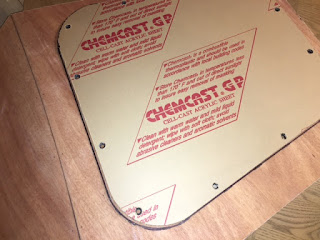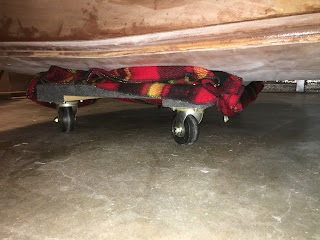As mentioned in the previous post, I assembled the part of the trailer frame that mounts to the camper and set it on the bottom of the upside-down camper shell:
So far so good, but as you can see I had to place the trailer frame on spacers to clear the butt block (risers will be added when the trailer is installed). This means the mounting holes are 3/4" away from the camper bottom, leaving a lot of room for error. Now I'm that much more glad I decided to do it this way, because there would be more possibility for error while lying on the ground under the trailer.
First I shined a small LED flashlight down through the mounting holes and outlined the projected circles of light. That was my first idea, but now I think a much surer way will be to use a square to project the outside edges of each mounting bracket down to the shell bottom and mark several spots around them. After I remove the frame, I can take off one of the mounting brackets and lay it over all the outlines to mark the hole locations.
So here's one of the hole locations marked using the second method outlined above. I think it will be pretty accurate, but the immediate challenge is getting the hole centered in the exact middle of the circle.
Here is one of the mounting holes drilled. I decided to make it 5/8" diameter instead of 1/2" as recommended in the manual to give me a little more wiggle room. The hole will be filled with thickened epoxy and a 3/8" hole drilled into the resulting plug. That only leaves 1/8" of epoxy around the hole. 1/16" would be too thin to safely avoid drilling into raw wood.
The bottoms of all the holes are covered with tape to keep the thickened epoxy in place.
Here is one of the eight holes filled with thickened epoxy. The epoxy was thickened with Cell-O-Fill this time instead of wood flour. That may be to make it stronger. You can't tell from the picture, but to borrow a woodworking term I left the epoxy a little proud, to be easily sanded flush later.
The small electric heater is still inside the shell and is turned on. I have made a plastic tent over the curing epoxy to allow some of the heat on the outside also, without having to heat the entire garage. The epoxy will be fully cured in four or five days, but it will be hard enough by tomorrow afternoon to allow drilling the mounting holes.
Next Day: Time to drill the mounting holes within the epoxy plugs. I used this contraption to keep the drill bit as perpendicular to the camper floor as possible. As you can see, I am using a Forstner bit. I used it to start the hole because it does not have the same tendency to "walk" as a twist drill. The Forstner doesn't do too well drilling epoxy though, so after drilling about 1/2" I switched to a twist drill.
Here's a finished mounting hole. I didn't get it perfectly centered but it's close enough that there is definitely no raw wood exposed.
One of the epoxy plugs had a large bubble that looks to be exposing wood, so I am going to fill it and drill it again. There were two more plugs that had significant enough bubbles that I decided to refill them also. This time I used the shank of a 1/16" drill bit to be sure I got any bubbles out of all three new fills. I'll drill those three out tomorrow and that should be that. Will leave the electric heater running inside the shell for 4 or 5 more days to be sure I get a complete cure.
I had thought I might be able to go ahead and permanently mount the trailer frame to the shell after this, but even though it is aluminum it is much heavier than I thought it would be. Also, I will probably need better access to the frame when I am installing the other trailer parts.





















































